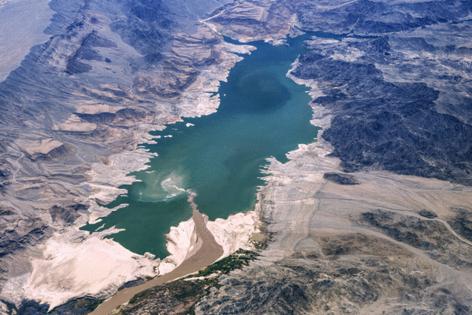Why warring Colorado River states could be headed for 'divorce'
Published in News & Features
LAS VEGAS — Deadlocked for months in tense, closed-door meetings, Colorado River states may be one step closer to an agreement.
Representatives from each of the seven Western states have agreed to discuss a new path forward — one that could more firmly ground Colorado River policy in hydrological reality as snowpack fails to deliver, reservoirs decline and fears mount.
“It’s something that’s actively being discussed,” John Entsminger, Nevada’s representative in interstate talks and general manager of the Southern Nevada Water Authority, said in an interview Wednesday. “But it’s not something where I can tell you what the score is in the third inning: The baseball game is still being played.”
The proposal, presented for the first time publicly at a meeting in Arizona on June 17, would base the release of water from Lake Powell on a three-year average of the “natural flows” of the river. Water released from Lake Powell ends up in Lake Mead, the source of roughly 90% of Southern Nevada’s supply.
Lake Mead is only 31% full, and measly snowpack has reignited discussions about a return to crisis levels seen in 2022, when the reservoir was at its lowest. The negotiation process must be finalized before the end of 2026, when the current operating regime expires.
The natural-flow proposal, while details remain sparse, would be a stunning departure from guidelines minted in 2007, which some argue don’t take into account declining water availability.
It represents a changing paradigm for the watershed serving 40 million people across seven states, Native American tribes and parts of Mexico, said Mark Squillace, an environmental law professor at the University of Colorado, Boulder.
“Everybody’s pretty much accepted that we’ve got to come up with a new formula for dividing the river,” Squillace said. “The devil’s in the details about getting the numbers right.”
In an impassioned speech at the Upper Colorado River Commission on Thursday, Becky Mitchell of Colorado confirmed that all seven states are taking a close look at this new proposal.
An official from Utah, during a Colorado River conference at CU Boulder last month, framed the consideration as a “divorce” between the Upper and Lower Basin states. All that would tie the states together is the percentage released from Lake Powell, effectively allowing them to work separately on conservation and other water management.
“What we know today is that for any approach to work, it must be supply driven, perform well under both dry and varying hydrologies, and adapt to uncertain future conditions fundamental to this ‘divorce,’ or how we call it in Colorado, the ‘conscious uncoupling,’” Mitchell said.
Mitchell doubled down on the Upper Basin’s refusal to adopt a set delivery obligation of water it must send downstream.
The Colorado official said she’s disheartened by the Lower Basin states’ accusations of the northern states failing to produce more water, and she pointed to tough cuts the northern states already have made in dry years. Ranchers have been forced to sell off cattle and buy hundreds of thousands of barrels of hay, and farmers are struggling to make crop yields productive, she said.
“The Lower Basin must also understand that releases that they received from Lake Powell under the 2007 guidelines are not sustainable, because the water is just not there. It’s not in storage, and it’s not in the river,” Mitchell said. “The Upper Division states have met and continue to meet all of our commitments under the compact. We have, in fact, gone far above and beyond.”
The Colorado River Compact of 1922 divvied up water between the seven states, with Nevada allowed to use the smallest share by far. Return-flow credits, generated by water Las Vegas sends back to Lake Mead through the reclamation of water used indoors, allow the city to use more than its allocation.
“No amount of lawyering is going to fix the math problem,” Mitchell said, agreeing with the chorus of experts and officials who are doing everything they can to avoid a court battle that could last more than a decade.
If no proposal comes to fruition, Interior Secretary Doug Burgum and his staff have signaled that the feds are willing to decide themselves.
Scott Cameron, Burgum’s senior adviser, said at the Upper Colorado River Commission meeting Thursday that he has regularly briefed the White House on the status of negotiations.
“Secretary Burgum is prepared to exercise his authority as Lower Basin Water master and his options in the Upper Basin, as well, to make decisions himself,” Cameron said. “As a former governor, he really, really, really, would prefer to see a seven-state deal, and we are expending a significant amount of time and energy to try to help the seven states get to that place.”
Burgum is the former governor of North Dakota.
Elizabeth Koebele, a professor at the University of Nevada, Reno, said she’s hesitant toward any policy that would separate a watershed with a fate that is clearly connected. She is hopeful that the natural-flow proposal could be more aligned with changing conditions and said she wonders why a five- or 10-year average isn’t being considered, as well.
What remains uncertain is whether both basins will be equally committed to conservation if they do, indeed, divorce their interests, Koebele said. Should the plan fall apart and reservoirs plunge, Koebele warns that the states could revert to old legal arguments that again prove their hydrology is connected.
“If that happens, then this plan is really just another Band-Aid that works only until the situation is really dire,” she said.
What happens at the interstate level will have an effect on the future of Southern Nevada.
As the Las Vegas area booms in population, water managers have led the way in what Southwesterners can do to conserve, such as banning the watering of “nonfunctional turf,” offering cash for grass removal on private property and converting cooling systems. Much of the implementation has remained somewhat unpopular for longtime residents.
“If we hit our conservation goals, I believe Las Vegas remains the most water secure city in the Desert Southwest,” said Entsminger, of the Southern Nevada Water Authority. “We’re at the negotiating table, representing those interests.”
©2025 Las Vegas Review-Journal. Visit reviewjournal.com.. Distributed by Tribune Content Agency, LLC.







Comments